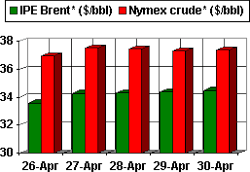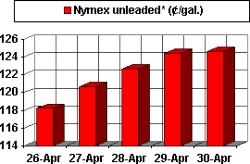Is US refining a sure bet for the foreseeable future?
Analysts who think so point to seemingly intractable infrastructure problems and the growing "boutique" nature of US gasoline markets as sustaining refining margins for years to come.
A long-term shortfall of gasoline supply looms for the US, contends Michael D. Tusiani, New York-based Poten & Partners Inc. chairman and CEO, writing a commentary in the Houston Chronicle.
Even the growth in US imports of gasoline won't stave off this day for long, he contends, adding that within 3 years demand will "hit the ceiling," as even foreign refiners aren't able to accommodate the robust growth in US gasoline consumption.
The result: government-imposed rationing or price allocating supply.
"The domestic refining industry has not grown significantly for years, and it will probably shrink in years to come," he wrote. "Plant emission rules, community hostility, and a series of money-wasting betrayals by regulators discourage expansion. So does the burden of paying for equipment to make fuels that comply with clean air rules for a marketplace so competitive that investments do not earn any money.
"Worse yet, these conditions encourage closure of marginal facilities."
The most recent example of that last observation is the bizarre picture of California Democratic Sen. Barbara Boxer clamoring for an investigation of Shell Oil Products US's plans to close its economically wobbly 65,000 b/d Bakersfield, Calif., refinery as somehow "anticompetitive" and a possible catalyst for higher fuel prices. Few politicians have been as consistently antioil as Boxer, and no state has been more hostile to refining and to the oil industry in general than California. The state is littered with the figurative corpses of refineries done in by its regulatory gantlet and draconian fuel specifications.
This situation is emblematic of the prodigious hurdles that must be leapt for the construction of new grassroots refinery capacity in the US. That puts a damper on the recent suggestion by Saudi Minister of Oil and Mineral Resources Ali I. al-Naimi that his country would be willing to invest in two 500,000 b/d capacity grassroots refineries in the US. While such a move would boost US refining capacity by 6%, the economic wisdom might be in question, according to Arlington, Va.-based Friedman Billings Ramsey analyst Jacques Rousseay: ". . .[S]ustained high margins would be needed to make a profit on a newbuild (refineries have sold at an average of 27% of replacement cost over the past 5 years)."
In any event, significant new capacity could not come on stream soon enough to avert a gasoline shortfall, says Tusiani. Assuming a continuation of gasoline consumption growth of 1.6%/year during the past 5 years, US gasoline demand would reach 9.2 million b/d in 2005 and 9.4 million b/d in 2006, he estimated.
Capacity creep
But could a return of capacity "creep" make the difference in the interim? This phenomenon, of upgrades allowing small increments of additional capacity, actually helped keep a lid on refining margins for a number of years (In the US, many of these upgrades were spurred by compliance with new fuel specs). However, capacity creep all but disappeared in 2000-01. Rebounding margins helped world refining capacity grow by 1%/year in 2003-04.
Using OGJ's latest Worldwide Construction Report data for refining projects, Rousseau estimated that global refining capacity will rise by an average 2%/year in 2005-06. He predicts that the average global refining margin will slip to a little over $5/bbl in 2006 from a peak of about $7.50/bbl in 2004 as a result.Yet he notes that most of that growth will occur outside the US and that there will be minimal US capacity growth during 2004-06.
That $5/bbl global refining margin doesn't sound so bad, even after a 33% drop, when one considers that it's about $2/bbl more than the 1999 average.
And that's a worldwide average pulled down by relatively weaker margins in Asia, scene of a surge in grassroots refinery construction. Much of that new construction is targeted to domestic markets showing astonishing growth in domestic gasoline consumption, such as China and India. Which brings us back to Tusiani's point: That building boom just isn't happening in the US and, at this point, doesn't appear likely to happen anytime soon.
Just as the highest gasoline prices in the US appear in the regions where the infrastructure is least able to meet the local boutique demands, the gridlock in US gasoline supply suggests stellar margins for US refiners at least to the decade's midpoint.
(Author's e-mail: [email protected])
OGJ HOTLINE MARKET PULSE
Latest Prices as of May 3, 2004
null
null
null
null
null
null
NOTE: Because of holidays, lack of data availability, or rescheduling of chart publication, prices shown may not always reflect the immediate preceding 5 days.
*Futures price, next month delivery. #Spot price.







